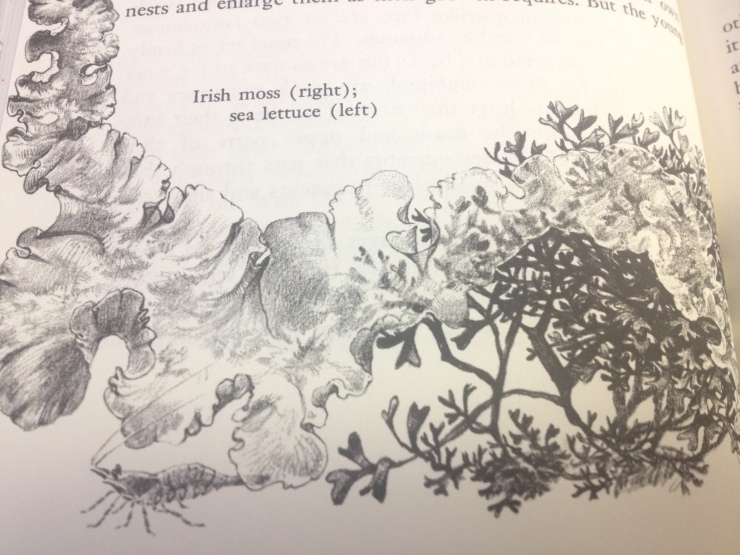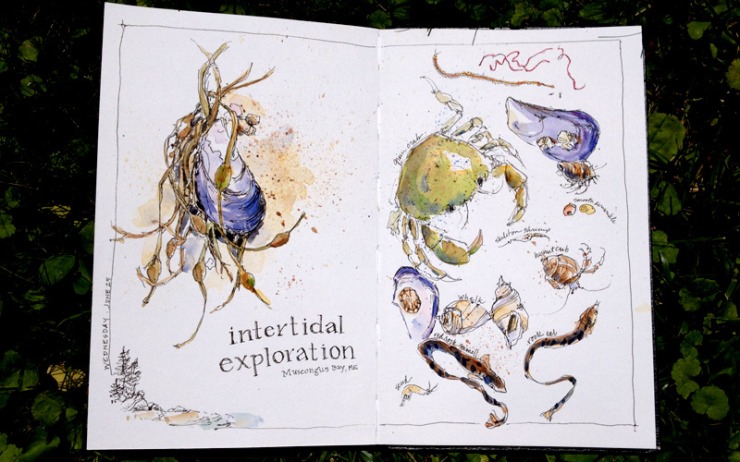“When we go down to the low-tide line, we enter a world that is as old as the earth itself — the primeval meeting place of the elements of earth and water, a place of compromise and conflict and eternal change,” wrote Rachel Carson in her enchanting book The Edge of the Sea.
Rachel Carson is known for writing Silent Spring, a groundbreaking exposé of the environmental problems caused by pesticide usage. Less well-known is her writing about the ocean. Carson began her career as an aquatic biologist for the U.S. Fish and Wildlife Service and produced a “sea trilogy” of bestselling books in the 1940s and 1950s: Under the Sea Wind, The Sea Around Us, and finally The Edge of the Sea.
In The Edge of the Sea (public library), Carson describes the diversity of the U.S. Atlantic coastline. Much more than a field guide, Carson writes with a beautiful clarity about our very human attraction to the seashore and the deeper understanding we can find there.
Like the sea itself, the shore fascinates us who return to it, the place of our dim ancestral beginnings. In the recurrent rhythms of tides and surf and in the varied life of the tide lines there is the obvious attraction of movement and change and beauty. There is also, I am convinced, a deeper fascination born of inner meaning and significance. – Rachel Carson, “The Edge of the Sea”
Carson first introduces the “patterns of shore life,” the forces that mold life at the shore: surf, current, tides, and even the very waters of the sea.


Carson then delves into the three basic types of seashores: rocky shores, sand beaches, and coral reefs. The Atlantic coast of the United States is one of the few in the world that provide clear examples of all three basic types.
Carson writes evocatively of different shorelines from Maine to Florida. She helps her readers look deeply at each of these different ecosystems and to imagine the lives of the plants and animals that live there.

Carson proposes that accurately identifying sea life is not enough. We must open our senses and our imaginations to truly understand.
To understand the shore, it is not enough to catalogue its life. Understanding comes only when, standing on a beach, we can sense the long rhythms of earth and sea that sculpted its land forms and produced the rock and sand of which it is composed; when we can sense with the eye and ear of the mind the surge of life beating always at its shores — blindly, inexorably pressing for a foothold.


For those who want to learn more about the marine life found in tide pools, sea caves, sandy shores, and coral reefs of the Atlantic coast, The Edge of the Sea is a wonderful guide. It is grounded in scientific discoveries, though some of the science has gone further in the 60+ years since its publication. Carson’s exquisite writing is timeless – you owe it to yourself to read her work.
The Edge of the Sea is the perfect companion for your next exploration of tidal pools or when you go beachcombing in the city. It is also makes a good bedtime reading choice when you want to dream about the ocean.
Have you read this book or others by Rachel Carson? What did you think?
Also, if you’re looking for more nature reading inspiration, check out these other worthwhile books.




A beautiful featured image at the top of your post. Coastlines are one of my favourite places. Thanks for reminding me about Rachel Carson’s sea writings.
LikeLiked by 1 person
Thank you, Sally. You are such a wonderful photographer – your comment is a true compliment : )
LikeLiked by 1 person
Absolutely a must read for ocean lovers and tide pool explorers. Rachel Carson writes with the rare gift of poetry and science — The Edge of the Sea is a gift that is worth returning to again and again. I’m honored that you found a place for my artwork with this post.
LikeLiked by 1 person
Thank you, Jean! I am so inspired by your beautiful illustrations and hoped it was appropriate to include one of your works in this post on “The Edge of the Sea.” I read on your site that you actually create some of your art on the scene at the tide pools and other locations. Stunning.
LikeLike
Yes– I love sketching in tide pools– it makes for fast, fresh, sketches that are a great record of the things I find each year. You just have to make sure you don’t turn your back on the tide. In Maine, it can start to come in fast. Rachel Carson was known to spend long hours in cold Maine tide pools and I love her descriptions of her discoveries in the Edge of the Sea. Good luck with your pursuit of exploring nature in the city!
LikeLiked by 1 person